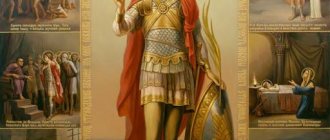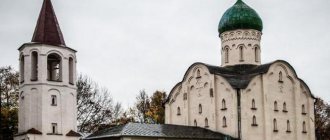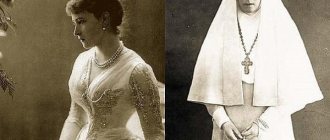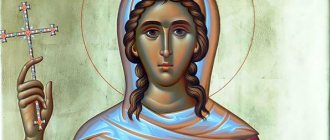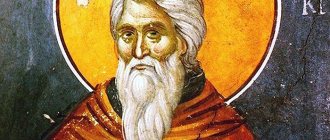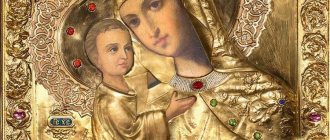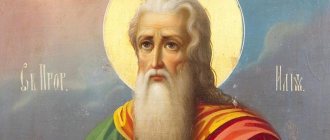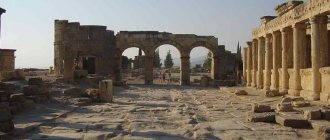In modern times, the name Victoria, which means “victory” in Latin, has become widespread. Sometimes in notes submitted about health, the name Victoria given at baptism is replaced by Nika, which has the same meaning, but in the Greek version. Many Orthodox believers doubt whether such a name exists in the calendar and whether the icon “St. Victoria” is revered in Orthodoxy. If you named your daughter Victoria, rest assured that she has her own heavenly patroness, moreover, there are even several such saints.
What does the name Victoria mean?
The name has a Latin root and means "victory". Each name has its own aura, which is superimposed on the child’s personality and shapes the character. Victoria must have “character”: be able to resist other people’s opinions if she is confident that she is right.
Outwardly determined and unyielding, she takes undeserved insults to heart. In everyday life, Victoria is a little lazy and slow, waiting for help from her parents in her studies. The uniqueness of the character lies in the combination of contradictory traits: ambition and shyness.
It is necessary to distinguish the Latin name Victoria from the Greek Nick, which in translation has the same meaning.
In 2011, the name Victoria was included in the calendar. This was done in memory of Saint Victoria of Corduba, an early Christian martyr. From this time on, the sacrament of Baptism occurs in honor of this saint if the baby is named Victoria.
Can a child be baptized only with an Orthodox name?
Reader question:
Peace be with you, father! Where can I find the full contents of names that can be used to baptize a child? It turned out that Victoria can be baptized Victoria, because there are several saints with that name, although I was always convinced that for the baptism of Victoria there is only a “baptized” name Nika. It turns out that people, and even Orthodox Christians, called their daughter one name and baptized her with another, despite the fact that it is translated the same way. I'm interested in the name Camilla of Ravenna. Her life and day of remembrance are given in the Orthodox Church, is this true? But many people dissuade us, saying that in Rus' there are already so many saints, glorified and revered by the Russian Orthodox Church, why do we need Western ones. and here a question arises, rather more rhetorical, after which unpleasant embarrassment sets in. How do Western saints differ from Russian and Greek saints, whose names are more common in Rus'? Did the Western saints please and suffer less for our Lord? Or is it that our Church cannot be completely confident in the authenticity of canonized saints?
Priest Viktor Nikishov answers:
For a long time in the Russian Orthodox Church there was a strong tradition according to which in the Sacrament of Baptism the names were given only to those people who were glorified as saints. The most complete list of saints' names is in the monthly book. The tradition of naming in honor of saints is connected with the fact that a person has a heavenly patron to whom he can turn for intercession. Every day, Orthodox Christians perform a service in memory of the saints whose day is on the calendar today. There are always several of these names; sometimes the number of saints remembered at the service reaches several dozen. Thus, you can see that there are a very large number of saints after whom a child can be named.
In 1054 the Church was divided into Western (Catholic) and Eastern (Orthodox). It is not customary to name after the saints of the Catholic Church who lived after 1054, since the Catholic Church has been in schism since that year, that is, in schism; accordingly, the saints recognized in Catholicism remain outside the framework of the Orthodox Church. The Holy Synod of the Russian Orthodox Church in 2022 decided to add to the Orthodox calendar some saints who lived before the split of the united Church into Eastern and Western. If we remember that there are 15 Orthodox Local Churches (generally recognized) and each has its own monthly calendar, then the number of saints after whom one can name a child turns out to be enormous.
Saint Camilla of Ravenna was born in Italy, in the city of Centumzella (modern Civitavecchia) in the 5th century. She is revered in the Russian Orthodox Church and her day is celebrated on March 3rd. We honor our saints because they are closer and dearer to us, like fellow countrymen. But no one forbids naming a child in honor of Saint Patrick, the saint of Ireland, or in honor of Luarsab II, the holy martyr king of Kakheti, who died in 1622, or even in honor of the Vukashin martyr of Klepac.
In addition, we all understand that the saints themselves did not always bear the names of saints, especially the first saints. For example, before the Apostle Peter there were no saints with the name Peter, before the Holy Equal-to-the-Apostles Princess Olga there was no Saint Olga, because representatives of all nations bore national names before receiving baptism. With this in mind, the Holy Synod of the Russian Orthodox Church allowed the Sacrament of Baptism to be performed while preserving for the person being baptized his national name, which is not in the Russian month book.
As for the question about the heavenly patron and the guardian angel, they need to be distinguished, how will the answer to the question Name Day and Angel Day help - what is the difference?
And as for the saints, any Christian can pray for help to any saint, and not just the one whose name he bears.
Source
The church remembers this name on days like this
In Orthodoxy, the names of Saint Victoria are known who suffered for the Christian faith during persecution in the 2nd-3rd centuries A.D.:
- Ephesus;
- Solunskaya;
- Nicomedia;
- Kuluzskaya;
- Cordoba/Corduba/Corduvian.
By the names of the martyrs one can judge where they lived and suffered martyrdom.
The name Victoria is commemorated, respectively, 5 times a year:
- June 7;
- June 14;
- November 6;
- 21 December;
- November 30th.
The ancient Orthodox churches in the West, until the 10th century, venerated 3 more martyrs under this name. It is known that one of them was Edist’s maid and died with him around the year 60. The other, together with her sister Anatolia, lived in Rome. The sisters refused to marry noble Romans who professed paganism and were put to death. Victoria of Albitinskaya was among the 46 Christian martyrs put to death for their faith in the city of Albitin in North Africa.
Origin
Nika's parents are considered to be Pallant, a younger titan whose father was the brother of Kronos, but who refused to oppose his father. Nike’s mother was Styx, the same one in whose honor the river of the dead in the kingdom of Hades was named. Moreover, Nika had 2 brothers and a sister - Kratos, Zel and Biya. We know very little about the childhood of the titans, even their last generation. It can be assumed that they received the enormous power of their parents, as well as incredible abilities in magical terms.
However, we know nothing more about their childhood. However, it is permissible to assume that these titans, including Nika and Biya, were raised to be warlike. This, for example, is evidenced by the statuses received by all the children of Pallanta and Styx. So, for example, Kratos was considered almost the god of war and definitely one of the strongest warriors, for it was he who “broke” Prometheus and chained him to a rock. Zel was the deity of envy and rivalry, and Biya personified violence as such.
Of all of them, Nika stood out with her reasonable approach, who became a goddess - the personification of victory. At the same time, her influence and fame in the world of mythology far exceeded the influence of her relatives. From this we can conclude that Nika was not only the wisest of them, but also the strongest, and also the most sought after.
What do they pray for, what do these icons help with?
In the holy images of the martyrs Victoria is depicted as young, beautiful girls in a similar outfit: a blue tunic, a red cape, a light veil on her head. In their right hand they hold a cross. What is different is the icon of Victoria of Corduba, who holds two arrows in her left hand.
In prayer appeals to the icons of the holy martyrs they ask for health, help in everyday troubles, strengthening of faith and spirit. Victoria of Corduba is revered in the Catholic Church of Spain and the South of France. People pray to her icon during a strong thunderstorm to protect homes and plants from lightning.
Prayer to St. Martyr Victor of Damascus
O holy saint of God, glorious martyr Victor! Having fought the good fight on earth, you are the crown of righteousness in heaven that the Lord has prepared for all who love Him. Yet, looking at your holy image, we rejoice at the glorious end of your home and honor your holy memory. But you, standing before the throne of God, accept our prayers and bring them to a merciful God, forgive us all our sins and help us rebel against the tricks of the devil and get rid of pain, illness, problems, misfortunes, etc. all evil, we will live righteously and pious. Today we will be honored by your intercession, if you do not deserve to be, to see good in the land of the living, glorifying the one glorified God, Father and Son and Holy Spirit, now and forever. Amen.
Days of remembrance of the holy martyrs:
- Victory of Nicomedia - October 24 / November 6;
- Victoria Kordubskaya - November 17/30;
- Victor Damasco - November 11/24.
- Victoria Kuluzskaya - December 8/21;
Holy Martyr Victoria of Corduvia
Victoria was a native of the Spanish city of Cordoba (Corduba), where she lived with her brother Acisclus at the beginning of the 4th century. During this period, the reign of the Roman Emperor Diocletian ended. The ruler was a pagan, but throughout all the years of his reign he treated Christians favorably.
The church was considered illegal, but its followers could build buildings for rituals and conduct missionary activities. The emperor considered the spread and strengthening of the new creed a threat to the existence of the Roman Empire. He issued 3 edicts, as a result of which open terror against Christians began in all Roman provinces.
Emperor Diocletian ordered the founders of the heads of territorial entities to be punished by burning, and followers, primarily fanatics, to be executed. After identifying secret Christians, informers were entitled to the property of those executed.
Acisklus and Victoria did not hide their Christian views. Acisclus was the first to be summoned for questioning and, by court verdict, was beheaded in the city amphitheater. The sister was asked to make a sacrifice to the ancient Roman gods and renounce Christ. Victoria refused and was shot with a bow. The remains of the martyrs were secretly bought by a noble Cordubian matron and transported to her estate, where they were buried. After the amnesty and restoration of Christians' rights, a church was erected on this site, and later a monastery was organized.
Victoria Kuluzskaya
At the beginning of the 5th century, North Africa was conquered from the Roman Empire by the Vandals and a state was formed. It included the territories of modern Tunisia, parts of Algeria and Libya. In the former Roman provinces, by this time a third of the population adhered to Christian views. The new doctrine went through a period of formation of the foundations of dogma and philosophy.
A religious movement appeared in Alexandria, the founder of which was the priest Arius. The essence of the heresy was the denial of the unity of the Trinity, not the recognition of Jesus Christ as God. The followers of Arius became the support of the ruler Guneric in consolidating his power.
Supporters of canonical views were subjected to severe persecution by the Arians with the support of the authorities. Non-Aryan Christians had their eyes gouged out and their legs mutilated. Victoria from Kuluza was a married woman with children. Her husband did not show resistance and accepted Arianism.
He persuaded his wife to do the same. Victoria did not renounce the ideals that Christ preached, for which she was severely beaten. She lost consciousness from severe beatings, and the tormentors stopped torturing her, deciding that the victim was dead. After some time, the true Christian woke up and saw that her wounds were healed.
Victoria of Nicomedia
It is known about the martyr who lived in Nicomedia that she was a young and beautiful girl, devoted to Christian teaching. Two magicians, Lucain and Markian, decided to bewitch Victoria. They used all the spells they knew, but did not get the desired result.
The young people decided to ask the girl why pagan spells did not work on her, and they learned that she was a Christian. Victoria helped them find faith in one God. Both friends publicly renounced the pagan gods, burned their magic books and became monks. During the persecution, Christians in Nicomedia were tortured and burned. The saint died at the hands of the pagans.
What Nika looked like
We can learn about Nika’s appearance from ancient statues. Unfortunately, Nike is rare in painting, but statues of her are found even more often than statues of much more significant Olympians.
Nika is a girl of incredible beauty. Forever young, forever young, with an elegant and slender body, which was hugged by the finest fabrics of clothing. Its characteristic feature was the presence of wings on its back. And in this way she is most like our traditional angels, who were also depicted in a similar style. Her hair was a beautiful chestnut color, and her hairstyle was reminiscent of Athena's hairstyle (a characteristic braid around her head), which was pressed with a laurel wreath.
It can also be assumed that Nika was very tall, because Her parents were titans, who, even by divine standards, were huge. Her attributes were a laurel wreath, as well as the staff of Hermes. According to legend, they divided it into two, for Nike, on her wings, was in no way inferior in speed to Hermes, on his winged sandals.
Hermes was the messenger of God, their messenger. He conveyed to the people what they had to do to satisfy the wishes of the Olympians. Nika was a harbinger. Her appearance motivated those competing or fighting, and this was the main difference between Nike and Hermes.
